Erg Chebbi Sand dunes:
Erg Chebbi, a small part of the Sahara desert. However, there is plenty of space to venture out and feel like you are alone in the world. These dunes have different names. For instance, some people call them the desert or the Sahara of Merzouga, a city that stands in southeastern Morocco. This haven of peace extends over a strip of about twenty kilometers long and about five kilometers wide. Also, the highest sand dune, Lala Merzouga, is about 152 meters, 500 feet. However, the shapes of the sand dunes change during the summer because of the wind. Therefore, the height can change from a year to another.
From the few towns in the region, access to the Erg Chebbi is easy. It is connected to many small villages besides Merzouga by a paved road. On the other hand, to enter the dune areas, you have to leave this road and take a track, which is easily accessible. Many tourist buses are already taking it, until the place where the campsites rise, this is the beginning of the adventure.
There are several ways to live this desert experience to the fullest. The first thing to do is to follow this sea of sand. A walk in the dunes, whatever the means of transport, promises a walk rich in discoveries. Each summit is the subject of a rest area to admire the view and landscapes of the Erg Chebbi.
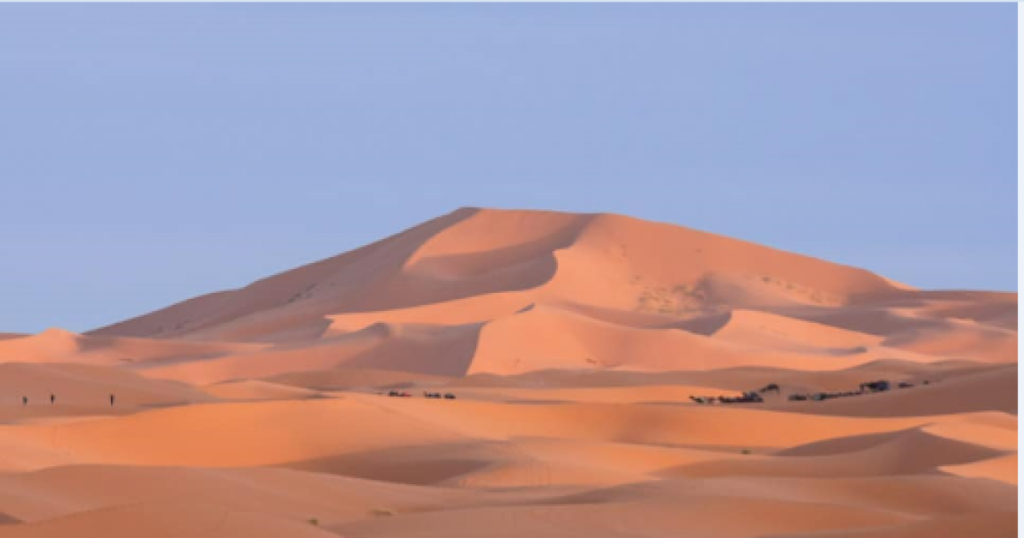
History of Erg Chebbi:
To specify its location, the Erg Chebbi is located in Tafilalet, in the south-east of Morocco, about 40 kilometers from the town of Erfoud and close to the Algerian border. Erg Chebbi is one of those places where ancient nomadic peoples lived.
In addition, there were also caravanners who passed by to sell their products in the surrounding cities or in some large Moroccan cities, such as Marrakech.
There are many theories about the existence of the dunes exactly in this area. Many people say that there was a lake here and because it is windy most of the summer. Therefore, it gathers here. Other people say that the Gnaoua, the slaves were fighting here, and there was a lot of murder and slavery. Therefore, God sent the sand in order to punish them.
Erg Chebbi today:
Nowadays, this immense wilderness sanctuary is one of the most popular attractions for those who want to follow in the footsteps of these nomadic people. Lovers of wide-open spaces will find their happiness there, while specialists will be delighted to discover the rock engravings and the majestic archaeological sites.
Vast and wild, the Erg Chebbi cannot be covered in one day. This is why camps equipped with all the necessary comfort have been built. However, this does not prevent adventurous travelers from setting up their wild bivouac in their favorite spot.
Today, countless hikers and excursionists, in search of a total change of scenery, rub shoulders with this part of the Moroccan Sahara. Some travel agencies could even propose to tourists to spend some events of the year there
When to leave?
The weather is beautiful all year round in the Moroccan desert. However, one must realize the big difference between day and night temperatures. In fact, even if it is hot all day long, about 28°C, the night can be icy and go down to 0°C, especially in winter.
Campsites can also be invaded by sand swirls when the wind rises. So, even though the Erg Chebbi can be visited all year round, the best time for this desert experience is between March and October.
Check out our article on “the best time to travel to Morocco“
A few tips for a successful outing in the desert:
Hikers should not overcrowd themselves, i.e. be as light as possible. A small satchel is enough to put accessories such as tissues, sunscreen, cameras, binoculars, water bottles…
On the clothing side, covering clothes are the most appropriate. Pants and a long-sleeved shirt, for example.
Since it is very hot in the desert, hiking shoes can be uncomfortable for the feet, so it is better to wear a pair of open sandals s worn with socks.
In addition, sunglasses and hats are essential to counter the sun’s rays. There are also cotton scarves typical of desert countries that protect against wind and sand.
For those who want to spend the night in a bivouac, it is necessary to bring a sleeping bag adapted to the local temperature and the possible freezing nights. Flashlights, toilet paper, Swiss Army knives, and a first aid kit are also very useful.
How to get there?
The nearest large city to this erg is Ouarzazate. The latter has an international airport and can book a direct flight from major European cities. Once arrived in Ouarzazate, one can take a cab, bus or rental car to leave for Merzouga, a small town before the erg Chebbi. It is located 360 kilometers from Ouarzazate, so it takes about 5 hours to get there.
After this asphalt road, one must continue on a track, easy to access, which leads to the dunes of the erg Chebbi and the corner of the campsites.
Some travelers choose to start the trip from Marrakech or Fez… The trip can be very long, but the scenery during the trip is worth it. From the red city, for example, you have to cross the famous panoramic road of the High Atlas to reach the rocky plains and palm groves of the Drâ a valley, to finish on the sandy sea of the desert.
How to circulate the Erg Chebbi dunes?
● On foot: Erg Chebbi is a site to explore on foot. It is absolutely necessary to cross the dunes before stopping in a place where to spend a moment in family or in a group…
● By 4×4: This means of transport is very popular with those who want to make an excursion to the most remote places.
● By quad: they are Faster and sporty, this is dedicated to thrill-seekers. In a group, in family, you just have to follow the guide’s tracks so you don’t get lost.
● On camelback: This is the most original way to explore the Erg Chebbi or the whole Moroccan Sahara. At the rhythm of these animals, you will surely spend one of the most authentic moments. An opportunity to try a new experience and to live in the time of the nomadic peoples who used to live in the Sahara Desert.
The Sahara and the surroundings:
Visiting the Sahara desert in Morocco is one of the most magical things you can do in the country. In Rissani and its surroundings, you can already “taste” the desert. You will not find meters high sand dunes, but a rocky sand desert with quite some vegetation, in the form of palm trees and thorny bushes. Only in Merzouga do you have that real Sahara feeling, with the imposing Ergs, or gigantic and endless sand dunes. Although technically Merzouga is only part of the pre-Sahara Steppeland, here you are in a crazy setting, which is on top of the desert. Both Rissani and Merzouga have their own charm and I would definitely recommend you visit them both.
Introduction to the desert in Rissani:
As you approach Rissani from more northerly regions of Morocco, you will notice that the landscape is getting drier and drier. In the end, there is little else to distinguish from the yellow desert soil and the equally yellow houses. Here and there is a group of palm trees or some dry bushes. In the center of Rissani, it is very busy, especially on Thursdays, when the weekly market is going on. Driving around the streets of the center, you really have the feeling of being in a cowboy town. The real beauty of Rissani, however, can be found outside the town itself. The ksar in the desert around the city brings you directly into the 1001-night atmosphere.
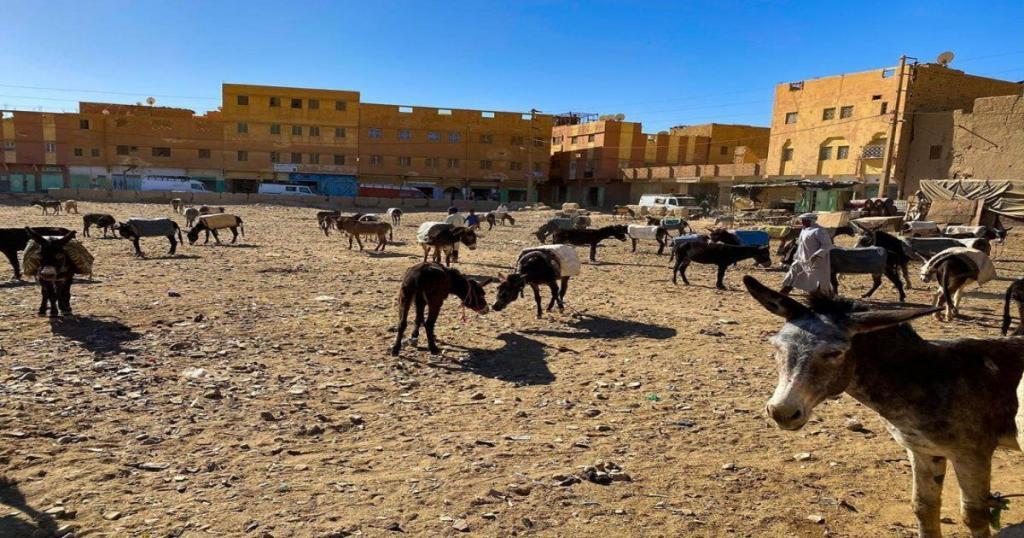
Circuit Touristique around Rissani – ancient ksar!
A round trip of over twenty kilometers, south of the city of Rissani, feels like a journey back in time. During your itinerary, you’ll find dozens of ksar, walled villages, built of clay. Once these Berber villages were thriving trading towns. Nowadays only a handful of families live in each of them. There is still no running water in the centuries-old houses, some of which look surprisingly modern inside. On the outside of the thick, mud walls there is usually a well, not far from the large main gate. Some of those gates are still impressive. Inside the walls, it’s quiet, as long as the village children haven’t spotted you yet. As soon as they spot you, they’ll surely follow you and ask for a “stillo” or “bonbon”.
You can follow the itinerary and without effort, you’ll find surprisingly photogenic villages and oases, which remain green with an ingenious watering system. Take at least two hours to make the whole tour and see one or two villages within the walls. Be sure to take a dirt road here and there to deviate from the main route. This way you’ll meet the locals, who do their laundry at the well or work in the palm grove.
Ksar Oualad Abdelhalim:
The Crown jewel of all this ksar is the Ksar Oualad Abdelhalim. This fortress was once a real palace, owned by Sultan Hasan Moulay’s older brother. This fortress is still inhabited and although parts of it are very dilapidated, other pieces are currently being refurbished. Wonderful to see how the old details of the towers, gate, and mosque are still preserved. If you don’t drive the entire Circuit Touristique, you can get to this ksar within five to ten minutes from the Eastern access road.
If you come with a guide, he or she will tell you many interesting details about the history of the ksar and the various buildings within the impressive city walls. Chances are, if you come without a guide, you will automatically run into someone who offers himself. If you have time, a walk in the surrounding countryside is also great. Here people still live as they have done for centuries in this part of Morocco. A man comes on his donkey, loaded with green, fresh eggs, and a real chicken. His wife hangs the wet laundry on a wire near the front door of their mud house.
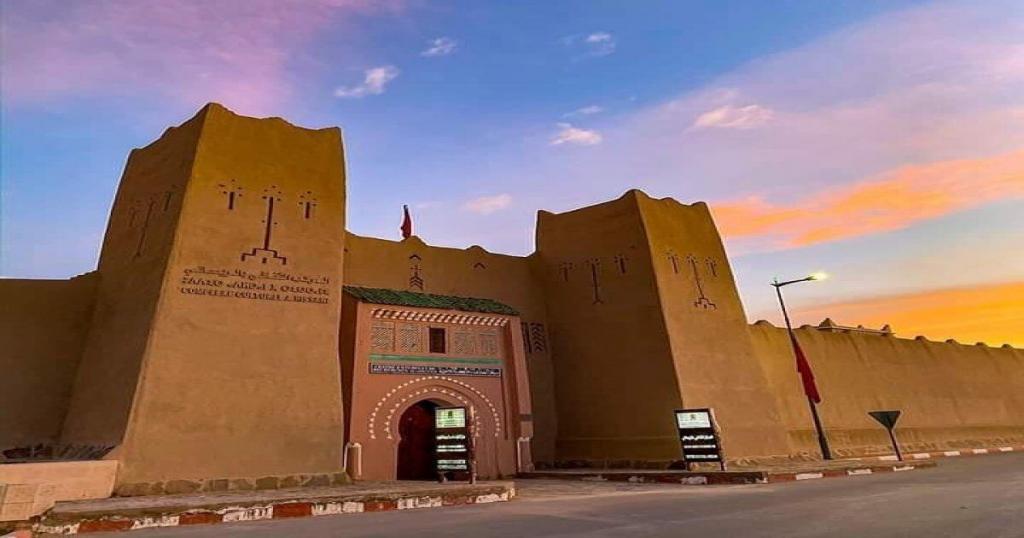
Merzouga – gateway to the Sahara desert:
From Rissani you drive in half an hour to Merzouga. The landscape is dry, barren, and flat. You’re already here in the desert. On the long, straight road you can drive quite a bit and in the distance, the sand dunes of Merzouga loom up. Where Rissani is still a town, Merzouga has a village character. It feels a bit like you’re in the last inhabited part of Morocco.
Almost on every side street of the only main road, you will find accommodation and from there you can enter the desert.
Looking for a travel agency in Merzouga?
Touring In Morocco is a travel agency in Merzouga, Morocco. You can book your Erg Chebbi desert tour from Fes, Marrakech, Casablanca, and also Tangier. The agency covers all the needs of travel to Merzouga, overnight camping at Berber tents, and camel rides on the dunes.
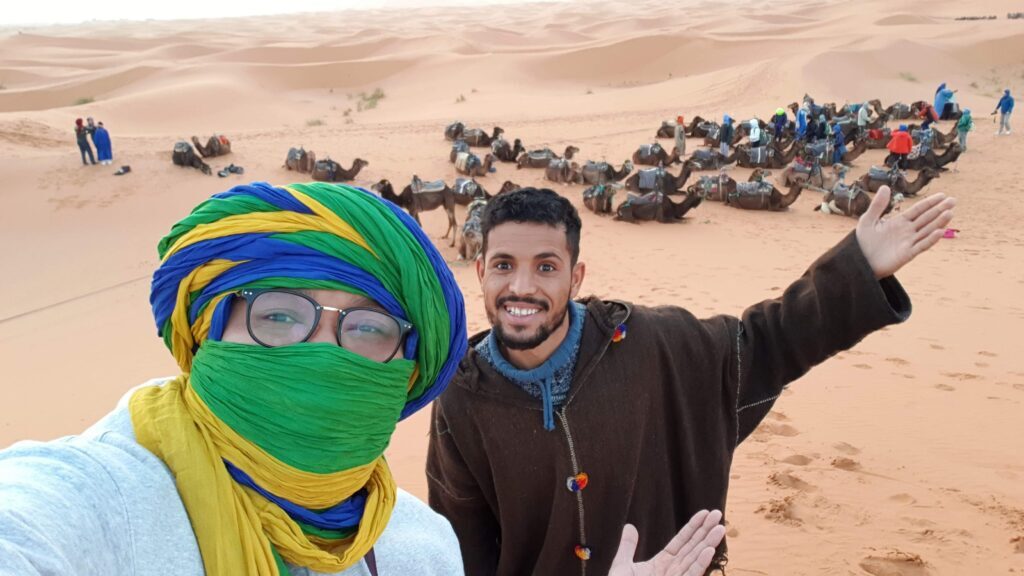
Experience of one of our clients in Erg Chebbi:
From Rissani you drive in half an hour to Merzouga. The landscape is dry, barren and flat. You’re already here in the desert. On the long, straight road you can drive quite a bit and in the distance, the sand dunes of Merzouga loom up. Where Rissani is still a town, Merzouga has a village character. It feels a bit like you’re in the last inhabited part of Morocco.
Almost on every side street of the only main road, you will find accommodation and from there you can enter the deSilence. What does the complete absence of noise sound like? When not even the wind takes the trouble to fill this vacuum with its noise. The acoustic perception is completely paralyzed. Yes, there is noise in my ears. But this is the blood that is pumped through my body by my heartbeat by beat. I look into a sea – of sand. 100 meters below, the inhabitants of the desert camp are still slumbering. The dune of Erg Chebbi, on which I stand, glows red in the sunrise when I realize that I hear only myself.
Close to the Algerian border, about 600 kilometers and a high mountain range from Marrakech, lies the Erg Chebbi. During our desert tour through Morocco, we visited the desert camp of Desert Luxury Camp located there. Far away, far away from any civilization. At first sight a hostile environment, at second sight full of magic. A strange place, which perhaps just because of the frosty winter temperatures prevailing in January has unfolded its whole magic.
The infinite sand sea: Erg Chebbi:
The sand seas of the Sahara are called Erg. The term means translated dune sea. Contrary to the first assumption, ergs store valuable water; contrary to the second assumption, only 20 percent of the world’s deserts are “real” sand deserts and thus ergs.
The Erg Chebbi is beside the Erg Chegaga one of only two pure sand deserts in Morocco. The area is only 22 kilometers long and 5 kilometers wide, surrounded by scree deserts and smaller villages like Merzouga and Erfoud, where many desert tours start.
Marhaba – Arrival at Desert Luxury Camp:
We sit down on soft cushions and, with a glass of mint tea in our hands, look at the setting sun. As if the desert scene would be incomplete without it, two camels appear on the horizon towards the camp. Guided by a camel driver, two guests ride on them, returning from a visit to a nomadic family.
Spacious white Bedouin tents flutter in front of us, which are set up in a semicircle to protect them from the wind. The free space in the middle is covered with heavy carpets, the largest tent serves as a restaurant for breakfast and dinner. Behind us a mighty sand dune, at its feet two sandboards waiting to be driven.
Our host Youssef, himself dressed in traditional djellaba and turban, has white clouds of breath in front of his face when he talks about the camp. The temperature changes here are enormous. In the wintertime it has pleasant 20-25 degrees during the day, but at night the thermometer sinks below the freezing point. But in the Desert Luxury Camp, you are well prepared for this.
Overnight in the camp:
After we have emptied the glasses, Youssef shows us the inside of our luxurious short-term accommodation. On more than 20 square meters a huge king-size bed dominates the scene. Four layers of blankets are provided to make our time as comfortable as possible. But actually it is surprisingly warm inside.
Youssef points to a radiant heater in the corner that bravely does its job. “The heater works until 11 o’clock but you can have as many hot-water bottles as you want” he diminishes the burgeoning optimism a little. Instead, there is an adjacent private bathroom with a shower and toilet. Luxury in the middle of nowhere.
1001 nights in a desert camp:
When we leave the tent again, it has finally become dark. In the meantime someone has made sure that we still find our way to the restaurant tent. In the reddish glow of hundreds of flickering lanterns the scenery finally slides into an oriental dream from 1001 nights.
At dinner we meet Youssef again, ask for personal food preferences and no-gos. He makes it clear that the cooking here is not according to a strict menu, but according to the wishes of the guests. On the lamb meat so popular in Morocco we do without, otherwise, we let us surprise. Not long after that, two traditional tajines steam in front of us, filled to the brim with chicken, couscous, and vegetables. Also, the only cat in the camp (how could it be different in Morocco – cats are everywhere here) gets its portion – the cook simply overestimated us with his portions.
Full to bursting we roll out of the restaurant after several “sukran” (thanks). At a big fire bowl in front of our water pipes and two drumming Moroccans are waiting for us. As our gaze wanders to the sky, the two of them move into the background. Billions of stars shine above us, the cloudy band of the Milky Way is clearly visible. To be able to see, even more, we steal away from it and move away from the camp into the pitch-black darkness.
The morning after:
A look at the clock, it is 6:00 in the morning. Still more than an hour until sunrise. It is comfortably warm under the four layers of blankets, thanks to the hot water bottles. Nevertheless, the cold tip of the nose gives you an idea of the frosty reality outside. No help, the sunrise is just not for wimps. By the way. When it’s freezing, it’s not so pleasant to take a shower in a private bathroom tent. Learned something again – next time during the day.
After all, the urge for sunrise wins. Get out of bed and up onto the dune that stretches towards the sky behind the camp. One step after the other, up the steep slope, this is the quickest way to chase away the cold – and is richly rewarded.
If the dunes are still pale pink in the semi-darkness, their color changes to pure gold at sunrise.
The complete silence in which this colorful natural spectacle takes place leaves a lasting impression. Breathe in. Breathe out. Enjoy.
Desert tour through Morocco planned? About the Desert Luxury Camp:
In the middle of the Erg Chebbi, the Desert Luxury Camp offers a particularly high-class possibility of experiencing the sand desert of Morocco in the context of a desert route. The large tents with attached bathroom, a variety of activities such as camel riding and sandboarding, as well as the dedicated staff make the stay a * experience that is second to none. Additional reviews can be found on Tripadvisor.
Many thanks to the Desert Luxury Camp, which supported this trip. Our opinion remains – as always – our opinion.

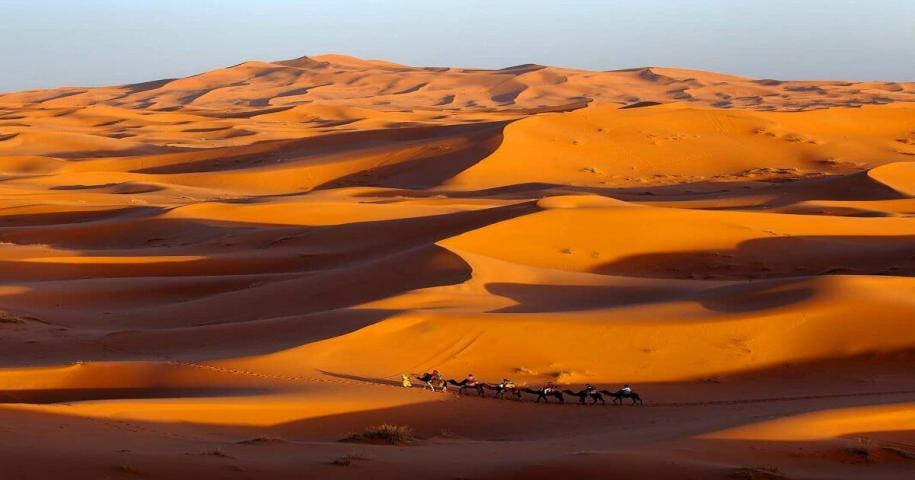
Leave a Reply